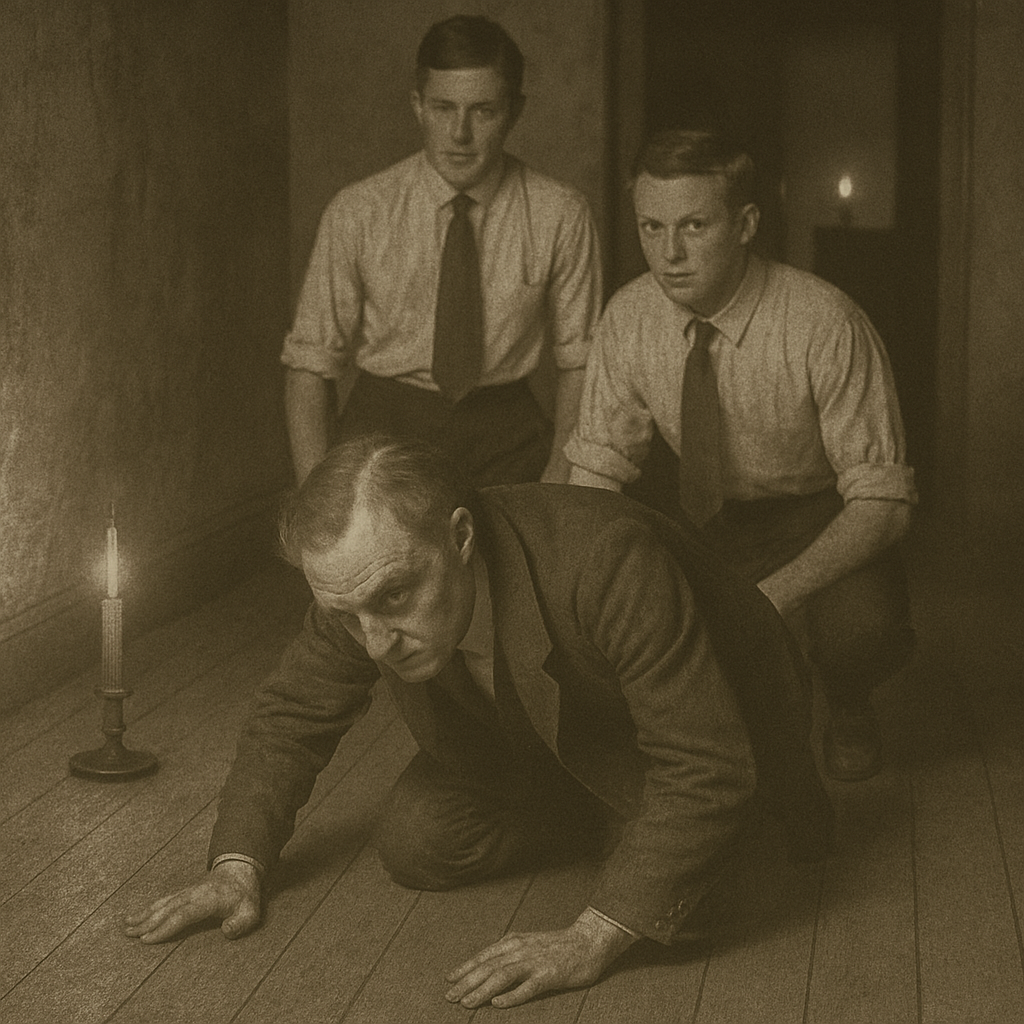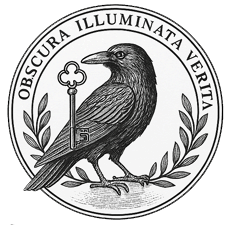File Reference: SCF-27B/FLR-LISTEN
Classification: Restricted Archive (Level V – Unverified Auditory Contact)
Initiated: March 1933
Terminated: November 1934
Status: Suppressed – Dangerous Residual Activity
Current Custodian: StormCroft Special Retention Unit, Box 12, Langport
In the South Wing, under layers of acoustic tile, staff uncovered wooden floorboards with embedded copper wire and bone dust. Walking across it barefoot caused faint whispers, repeating words not yet spoken. It is now covered in lead and locked.
Project Overview:

Believed to be one of the earliest known photographic records of a StormCroft psychoacoustic investigation, this image shows Dr. Elias Hardcombe, head of experimental auditory phenomena at the time, conducting a floor resonance session in an abandoned East Devon property.
Flanking him are two junior aides — Thomas Whitford and Julian Marr — who had been tasked with noting “any change in breath, tone, or timber of the floor’s response.” Candles were used in place of lanterns due to flickering disruptions observed during previous attempts.
The photograph was developed privately by Archivist Agnes Well, and later classified under Retained Documentation Order VI, following Marr’s withdrawal from the programme and subsequent institutionalisation.
Historians believe this moment captures the first direct contact with what StormCroft would later define as Subsurface Auditory Memory Structures — phenomena which, as the records put it, “do not echo us. They remember us.”
The Listening Floor was a classified psychoacoustic and geomagnetic investigation run under the StormCroft umbrella between 1933 and 1934. It sought to study a string of anomalous events reported across properties in Devon and Somerset — specifically, houses where residents reported hearing sounds beneath their floorboards that were neither structural nor natural.
The phenomenon shared several chilling traits:
-
The sound was always described as “deliberate but distant speech”
-
It occurred only in silence and only when the listener was alone
-
The voice(s) seemed to respond, though never in any known language
Initial Purpose:
StormCroft originally believed this to be related to residual psychic phenomena — emotional imprints left in floor joists and foundations by past trauma. However, recordings and resonance tests began revealing untraceable sub-audible pulses and vocal shadows that defied architectural explanation.
These findings led to the formation of Project FLR-LISTEN, also known informally as “The Listening Floor,” named after the term used by field agent Dr. Eleanor Vayne, who first documented the phenomenon at Marsh Hollow, near Bovey Tracey.
Notable Personnel Involved:
-
Dr. Eleanor Vayne – Lead psychoacoustic field agent. Last known correspondence referenced “binaural shaping inside the boards.” She disappeared in late 1934.
-
Jonathan Rickards – Carpenter and StormCroft sympathiser. Provided access to sealed subfloors in condemned properties. Suffered auditory breakdown in summer 1934.
-
Brother Malley (Order of Obscured Scribes) – Brought in to attempt ritual isolation of affected rooms. Advised immediate destruction of three recording units.
Termination of Project:
The project was officially terminated after Incident IV-Rosemont, wherein an intern at the site removed their shoes, lay flat upon the floor, and whispered continuously for eleven hours, later found unresponsive and unable to hear human speech — though reportedly reacting to wood creaks and furniture shifts.
An internal memo dated November 12, 1934, reads:
“The floor is no longer listening. It is now remembering.”
All research logs, reels, and resonance notes were ordered burned or bricked, with a final message etched in chalk inside the Langport facility:
“We did not build this. We only uncovered what already listens.”
Legacy & Recurrence:
The term Listening Floor was subsequently blacklisted from all official StormCroft documentation until 1961, and remains under passive suppression protocols.
The 1935 silent film of the same name is believed to be an unauthorised dramatisation inspired by the project, created by individuals loosely affiliated with the field team. Its release is strongly discouraged by the Archive, citing a risk of “auditory sympathetic resonance” in susceptible viewers.
As of April 2025, the original location of Dr. Vayne’s last test site remains unknown.
